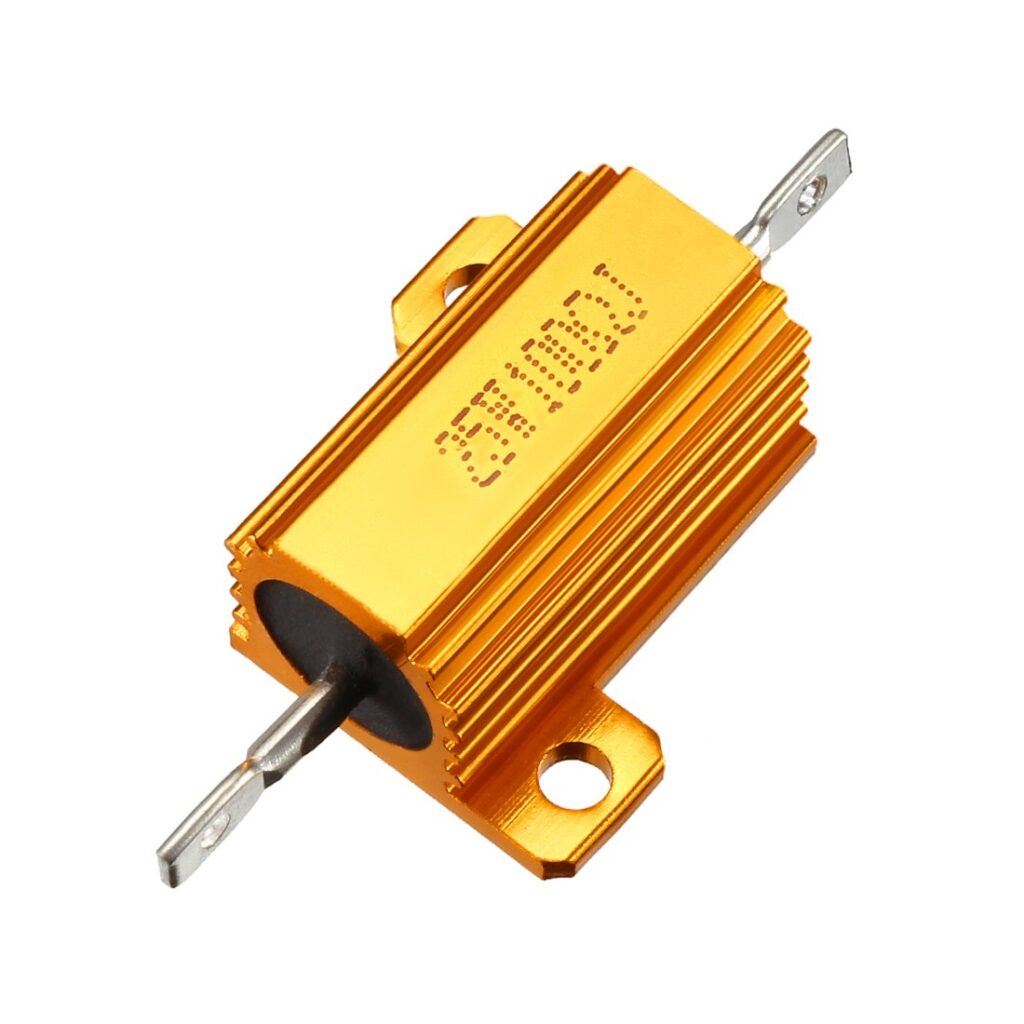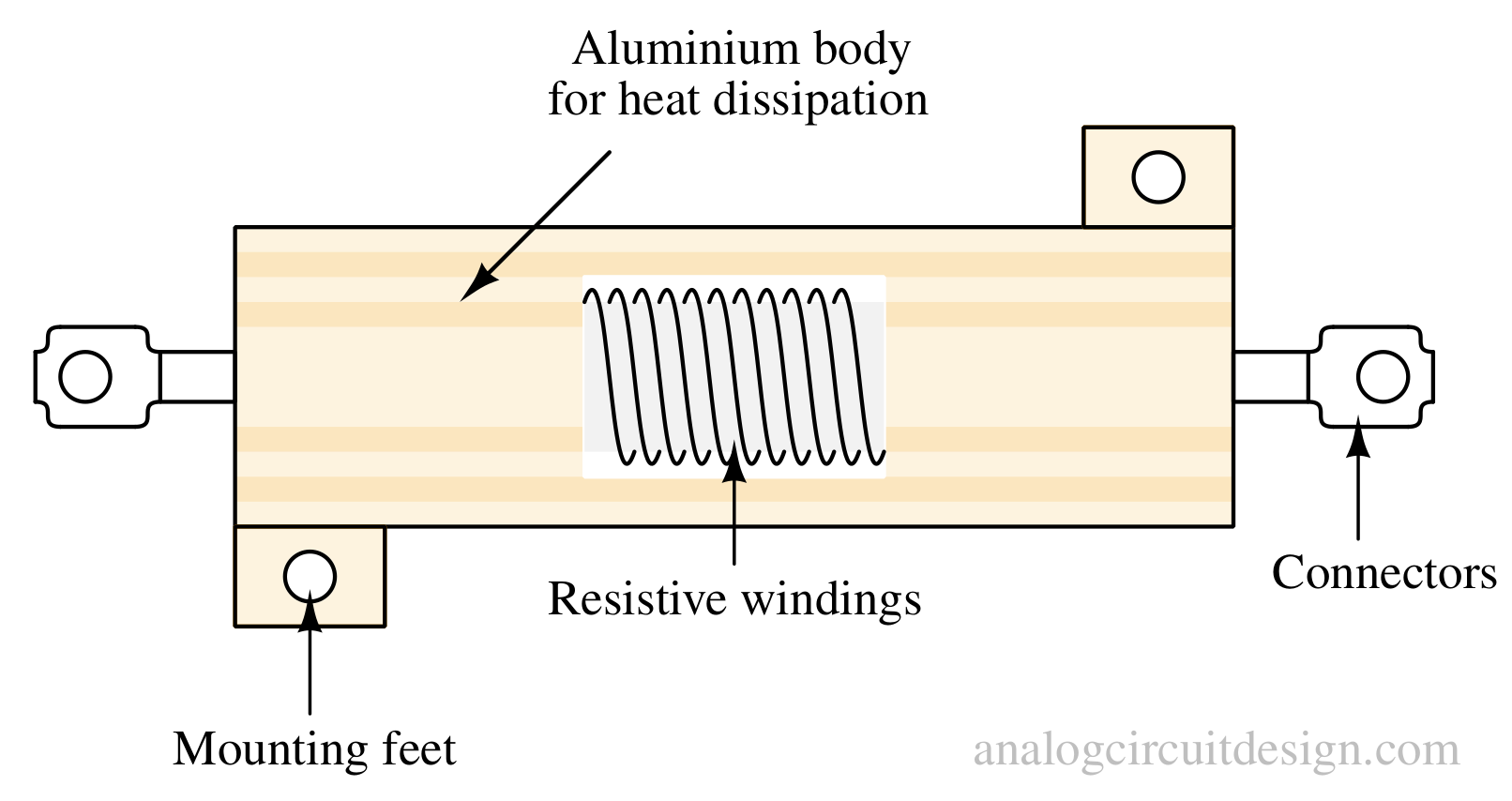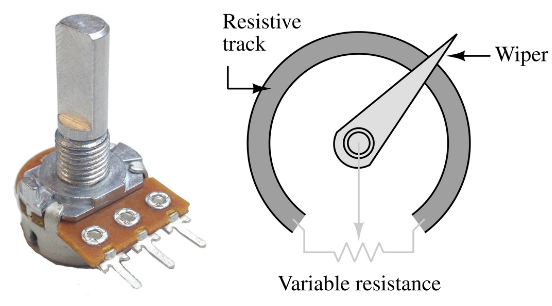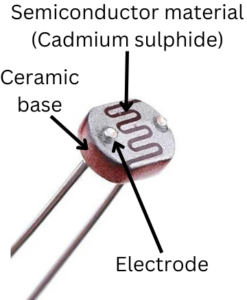Types of resistors
Fixed resistors¶
These resistors have a specific value and these values cannot be changed. Usually, these are inexpensive, compact, and come in many values. Following are the different types of fixed resistors:
Carbon composition resistors¶

Carbon composition resistors are typically cylindrical or oblong in shape and are composed of a mixture of carbon powder and a non-conductive binder material. The carbon particles are evenly distributed throughout the resistor's body. These resistors can have a relatively high Temperature coefficient compared to other types, making them less stable in high-temperature environments.

The big advantage of carbon composition resistors is their ability to withstand high-energy pulses. When current flows through the resistor, the entire carbon composition body conducts the energy. In contrast, the wire-wound resistor has a much smaller volume of wire to conduct current.
Wire wound resistors¶


Wirewound resistors usually consist of a substrate of high-grade special ceramic material of high mechanical stability onto which a single layer of wire or ribbon resistance element is wound with a single pitch. The winding material is usually an alloy like :
- Copper-nickel alloy (CuNi)
- Nickel-chromium alloy (NiCr)
The coating applied on wire-wound resistors (glazing, cement, lacquering) fixes the winding mechanically and prevents short circuits. It protects the resistance elements against mechanical damage and detrimental contamination by the environment. The protective coating also provides electrical insulation.
Thin film resistors¶
The resistor which uses a thin film (0.1 um) resistive layer over a ceramic base is known as the thin-film resistor. The construction of the film resistor is done through a sputtering process of the resistive material over the ceramic. This allows the thickness to be well controlled. Since these are thin; the resistance values obtained are very high ~0.2 to 20 MOhms.
These types of resistors are used inside integrated circuits due to their high sheet resistance and compatibility with the semiconductor manufacturing process.
Foil resistors¶
The foil in the foil resistors is made of an alloy of usually Nichrome (NiCr) with additives. It is mounted on a ceramic carrier with high heat conductivity. The foil has a thickness of only several micrometers. The desired resistance value is achieved by a photoetched resistive pattern in the foil. The metal foil resistor has a low-temperature coefficient of resistance (TCR), good long-term stability, low noise, low capacitance, fast thermal stabilization, and no inductance.
The typical temperature coefficient of a foil resistor is < 1ppm/°C while the temperature coefficient of a carbon resistor is ~1200ppm/°C.
Variable resistors¶
Rheostat¶
A rheostat is a variable resistor that is used for controlling the electric current flow. The construction is very similar to the construction of potentiometers. It uses only two connections, even when 3 terminals (as in a potentiometer) are present. The first connection is made to one end of the resistive element and the other connection to the wiper (sliding contact). The third connection is kept open.
Potentiometers¶

A potentiometer is a passive electronic component. Potentiometers work by varying the position of a sliding contact (wiper) across a uniform resistance. In a potentiometer, an input voltage is applied across the whole length of the resistor, and the output voltage is the voltage drop between the one fixed terminal (reference) and the wiper terminal. Most potentiometers have a shaft with a knob.
Trimpots¶
Trimpots are also potentiometers except these are adjusted with a small tool. They are not intended for frequent adjustment and may have a limited mechanical lifetime. These are meant to be adjusted only during production or calibration. These may be used to adjust the resistance, gain, current, etc. of a circuit.
These can be wired (terminal 2 shorted with either 1 or 3) to create variable resistance. That is called a preset resistor.

Sense resistors¶
Flex resistors¶
A flex sensor measures the amount of deflection or bending. A resistive material is spread over the surface, and the resistance of the sensor element varies when the sensor element is bent.
Magneto resistors¶
Magneto resistor is a type of resistor whose resistance changes when an external magnetic field is applied. This change in resistance can be linear or nonlinear depending on the specific type of MR sensor. Types of Magneto-resistors :
- Anisotropic Magneto-Resistors (AMR)
- Giant Magneto-Resistors (GMR)
- Tunnel Magneto-Resistors (TMR)
Thermistors¶
A thermistor is a temperature-sensing element composed of sintered semiconductor material that exhibits a large change in resistance proportional to a small change in temperature. Thermistors usually show negative temperature coefficients which means the resistance of the thermistor decreases as the temperature increases.
Light dependent resistors¶
A photoresistor or light-dependent resistor (LDR) or photocell is a light-controlled variable resistor. The resistance of a photoresistor decreases with increasing incident light intensity. In other words, it exhibits photoconductivity.
It is usual for the resistance of an LDR to be several megohms in darkness and fall to a few hundred ohms when exposed to b\right light.

Strain gauges¶
A strain gauge is a sensor whose measured electrical resistance varies with changes in strain. Strain is the deformation or displacement of material that results from an applied stress. Stress is the force applied to a material, divided by the material’s cross-sectional area.
Through hole resistors¶
All real resistors can be categorized into either through hole resistors or surface mount resistors. "Through-hole" resistors have wire leads that pass through holes in the printed circuit board (PCB) or other mounting surfaces for soldering.
SMT (Surface mount technology) resistors¶

While through-hole resistors are still widely used, surface mount resistors (SMD) have become more popular due to their smaller size and compatibility with automated assembly processes. SMD resistors are soldered directly to the surface of the PCB, eliminating the need for holes and wire leads.